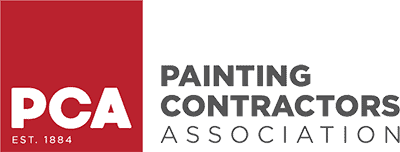The texture and color of a ceiling significantly affect the overall appearance of a room. For instance, smooth, white ceilings make a room feel larger. Textured ceilings like popcorn ceilings help cover up any imperfections while also providing a functional purpose, namely noise reduction. However, while textured ceilings can hide seams and cracks, they will still require a fresh coat of paint at some point. But painting a textured ceiling and a smooth ceiling aren’t exactly the same process. While much of the prep work remains the same, there are some additional techniques and considerations to take into account when painting a textured ceiling. Let’s look at how the pro painters get it done, step by step.
Set Down Drop Cloths
First things first: professional painters will cover the floor with drop cloths so that excess material and wet paint doesn’t fall on it. While they’re at it, they will cover any furniture or other features that should be kept clean and dry. Lighter, smaller items can be removed from the room entirely.
Use Protective Gear
It’s always a good idea to protect oneself from paint and other debris, but it’s especially important when painting a textured ceiling. Gravity will quickly send this debris towards your face as you look up while you paint. The pros will wear goggles and even a facemask to keep this stuff away from their eyes, nose, and mouth.
Set Up a Ladder
No matter how short a ceiling is, using a ladder will make the painting process easier, even for taller folks. And for tall ceilings, this will be vital. Professional painters will choose a ladder that allows them to reach the ceiling comfortably and safely, and set it up properly.
Remove Any Excess Texture
With all the initial preparation taken care of, it’s time to actually start prepping the ceiling for interior painting. If a textured ceiling hasn’t been painted since installation, the texture might be drooping a bit over the wall edges. If so, the pros will carefully remove this excess texture with a screwdriver, letting the debris fall on the drop cloth. Note that older popcorn ceilings may contain asbestos. If this is the case, this excess texture should not be removed in this way. Instead, a professional should handle this process delicately.
Tape the Wall Edges
Once the edges are straight, professionals will tape the wall edges with painter’s tape. This will prevent paint from getting on the walls and ensure clean, straight lines. If the walls have been recently painted as well, home painters may use an easy release tape to prevent removing any of the recently applied wall paint.
Cut In With a Brush
Before going at the entire ceiling, painters will cut in all the edges with a brush, making sure to cover enough space for the roller to easily overlap the new paint. This makes the rolling process much easier and more even.
Use a Thick Roller Nap for First Coat
Textured ceilings require a thicker coat of paint to ensure full, even coverage. This is why most painting services will use a roller nap of about ¾ inches to one-inch thickness. To get a good amount of paint on the roller, the pros often use a large 5-gallon bucket filled with paint and insert a screen to help remove any excess paint on the roller. Depending on the size of the ceiling, the first coat might be applied in one go without having to apply more paint to the roller.
Using an extension pole and/or ladder, they will apply the first coat in one direction, making sure to not cover one section too heavily, as this will create an uneven finish. Then, they’ll let it dry.
Apply Second Coat Perpendicularly
After the first coat has dried, a second coat must be applied to ensure full coverage of the textured ceiling. This time, however, professional painters will roll in the opposite direction, perpendicular to the direction of the first coat.
Touch Up and Clean Up
Once the second coat is dry, the pros will look for any missed or uneven spots and touch them up with a brush. When they’re satisfied, they’ll start cleaning up right away, removing ladders, painting supplies, tape, covering, and drop cloths from the area.
All American Painting Plus Can Paint Your Textured Ceiling
Painting a textured ceiling requires a bit more effort and a thicker coat than a smooth one. If you’re not sure you can do it on your own, contact the professionals at All American Painting Plus. We specialize in interior residential painting and so much more. Give us a call today at (703)-620-5563!











